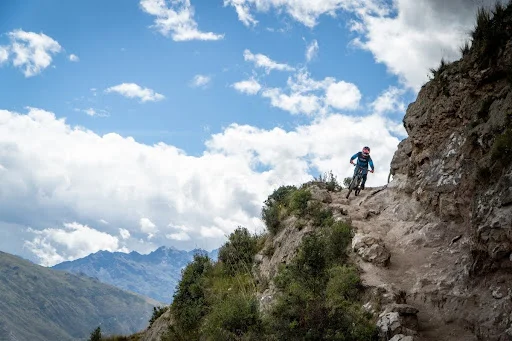The Peruvian Andes hide some of the most spectacular mountain biking or Mountain Bike Routes trails on the planet. Unlike traditional MTB destinations in Europe or North America, here you pedal along paths that the Incas built over 500 years ago, known as “qhapaq ñan” (the great road). Cusco, located at 11,152 feet (3,399 meters), and the Sacred Valley (Vilcanota-Urubamba Valley) have become the epicenter of mountain biking in South America.
The Peruvian Andes hide some of the most spectacular mountain biking trails on the planet. Unlike traditional MTB destinations in Europe or North America, here you pedal along paths that the Incas built over 500 years ago, known as “qhapaq ñan” (the great road). Cusco, located at 11,152 feet (3,399 meters), and the Sacred Valley (Vilcanota-Urubamba Valley) have become the epicenter of mountain biking or Mountain Bike Routes in South America.
This region isn’t just any valley. The Incas called it the “Sacred Valley” because its unique combination of moderate altitude (9,186 to 9,842 feet / 2,800-3,000 meters), temperate climate, and fertile land produced the finest white corn in the Inca empire.
This article shows you the best routes, how to prepare for altitude, what to bring, and when to travel.
Beyond the obvious—related posts uncover stories you never knew you needed.
Why Peru Is Different
Mountain biking or Mountain Bike Routes in Peru means riding through the Andes Mountain Range, the second-highest mountain chain in the world after the Himalayas. The Andean geography offers something unique: descents of over 4,265 feet (1,300 meters) on a single route, radical climate changes within hours, and landscapes ranging from glaciers to high jungle. The Vilcanota River sculpted these lands over millions of years, creating the perfect corridor that connected Inca urban centers like Pisac, Ollantaytambo, and the wonder of the world itself, Machu Picchu.
You don’t need to be a professional to explore these magical places. Routes adapt from beginners to experts, with local agencies offering full-suspension bikes valued at over $2,000 USD.
The 5 Best MTB Routes in Cusco
1. Lamay
One of the Sacred Valley’s gems. Lamay offers over 4,265 feet (1,300 meters) of continuous descent from altitudes above 13,123 feet (4,000 meters) down to the town of Lamay at 9,646 feet (2,940 meters), located alongside the Vilcanota River.
The descent combines technical sections with “Inca stairs” (carved stone steps that form part of the original trail) and fast stretches where speed becomes the star. The trails traverse puna zones (high-altitude ecosystem with natural grasslands) before descending into the valley proper.
2. Perolniyoc and The Other Side
This full-day route takes you through some of the Sacred Valley’s most photogenic landscapes. One of the most striking points is Perolniyoc waterfall, a roughly 328-foot (100-meter) drop that appears after hours of pedaling through narrow trails at heights of 12,467 feet (3,800 meters).
The route crosses the community of Socma, where families still maintain the Inca system of “vertical control of ecological floors.” They own plots at different altitudes to cultivate diverse products according to each zone’s microclimate.
3. Sacred Valley
If this is your first Andean experience or you prefer speed over technical difficulty, the Sacred Valley routes are your best option. These trails connect the valley’s main archaeological sites.
Wide curves, smooth sections, and fast descents let you enjoy the scenery without constantly worrying about obstacles. The valley here has a privileged climate: temperatures of 72-77°F (22-25°C) during the day thanks to its moderate altitude of 9,186 to 9,842 feet (2,800-3,000 meters).
4. Yuncaypata & Huayllarcocha
A classic for cyclists wanting to improve their technique before more demanding routes. Located on Cusco’s outskirts, this ride combines natural paths with communal trails. Tight corners and constant elevation changes force you to continuously adjust your technique.
5. Lares
Lares is more than a mountain bike route or Mountain Bike Routes. It’s a deep cultural experience in sacred territory. This area has natural hot springs dating from pre-Inca times. You pedal among herds of llamas and alpacas, crossing villages where Quechua is the primary language.
How to Handle Altitude Without Suffering
Altitude is the most critical factor when planning mountain biking or Mountain Bike Routes in Peru. At 11,152 feet (3,399 meters), Cusco has approximately 30% less oxygen than at sea level. This means each breath delivers less fuel to your muscles. “Soroche” or altitude sickness can ruin your trip if you don’t prepare properly.
Tips for Acclimatizing Before Riding in Cusco
- Rest, walk slowly, and avoid any strenuous effort. Your body needs time to adapt to thin air.
- Drink about 0.8 gallons (3 liters) of water per day; the altitude and dry climate accelerate dehydration.
- Try coca mate, a traditional and legal drink in Peru, used since Inca times to relieve altitude sickness.
- Do light activities on the second day. Stroll through the Sacred Valley or visit local markets; the lower altitude makes adaptation easier.
Essential Gear (What to Bring and What to Rent)
Professional agencies in Cusco rent high-end bikes with full suspension. Brands like Trek, Specialized, and Santa Cruz are standard. You don’t need to bring your own bike unless you’re very particular about your equipment.
Included in Professional Tours
- Full-suspension bike (value $2,000+ USD)
- Certified helmet
- Cycling gloves
- Knee and elbow pads
- Support vehicle with mechanic
- Repair kit and first-aid supplies
What You Should Bring
Bring layered clothing. In the morning, temperatures can drop to 41°F (5°C) and rise to 68°F (20°C) by midday. A light, waterproof jacket is essential even in dry season. Use SPF 50+ sunscreen and lip balm with UV protection: high-altitude sun burns in minutes.
Stay hydrated with at least 0.5 gallons (2 liters) of water daily and add electrolytes to replace salts. Pack energy snacks like nuts or chocolate, and don’t forget your sunglasses: they protect from both trail dust and intense Andean radiation.
Best Time to Ride
The Andean climate has two distinct seasons. Choosing correctly can transform your experience.
Between May and October, the weather is dry and stable, leaving trails firm and views clear of snow-capped peaks like Ausangate or Salkantay. Daytime temperatures range from 59 to 68°F (15 to 20°C), and nights can drop to 32-41°F (0-5°C), so a thermal jacket is essential. This is the best time to ride.
Safety and Final Tips
Mountain biking in Peru is safe when done with certified agencies. Guides have high-altitude first-aid training and each group has a support vehicle. Always ride with a local guide: Andean trails can be confusing and lack cell signal. Respect communal lands, reduce speed near animals, and keep distance from guard dogs. Carry travel insurance covering adventure sports and report immediately if you feel dizzy or fatigued; altitude demands caution.
How to Book Your Adventure
Operators like Peru Biking Tours offer options from half-day to week-long expeditions, with transportation, bike, bilingual guide, lunch, insurance, and support vehicle. During high season (June to August), it’s wise to book two weeks in advance. Average prices range from $100 to $1,200 USD per person depending on route, days, inclusions, and service level.
Your Turn to Ride
Mountain biking or Mountain Bike Routes in Peru combines extreme sport, ancient history, and cultural connection in a perspective-changing experience. Whether it’s your first time in the Andes or you’ve already pedaled in Nepal or the Alps, these trails offer the possibility to ride paths that connected an empire while sharing mate with farmers who keep centuries-old traditions alive.
Discover the hidden layers—explore more posts that turn info into inspiration.






